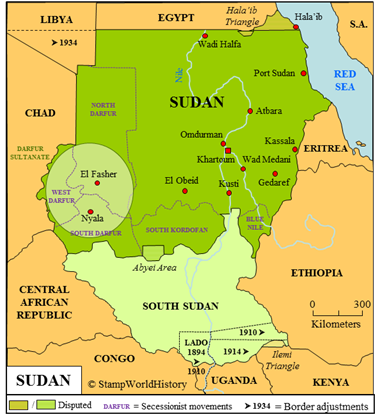
Sudan
Condominium – Great Britain

Sudan
Condominium – Egypt

Sudan
Current
Quick reference
General issues: Anglo-Egyptian condominium 1897-1952, Anglo-Egyptian condominium, self government 1952-1956, Republic 1956-1969, Democratic republic 1969-1985, Republic 1985-Present
Country name on general issues: Soudan, Sudan
Currency: 1 (Egyptian) Pound = 100 Piaster = 1000 Millièmes 1897-1953, 1 (Sudan) Pound = 100 Piaster = 1000 Millièmes 1953-Present
Population: 5 588 000 in 1900, 35 482 000 in 2014
Political history Sudan
Events leading up to the establishment of an Anglo-Egyptian condominium
Sudan is located in northern Africa. Sudan has a long history that, since the days of the pharaohs, has at times been intertwined with that of Egypt. In the early 19th century several independent polities exist in what is to become Sudan. In 1820 Egypt – at the time nominally part of the Ottoman Empire – successfully launches a campaign to conquer Sudan, thus establishing Egyptian rule over northern and central Sudan. Egyptian control is, subsequently, further extended to include most of Sudan by the 1870’s. Egyptian control will, however, come to an abrupt end through the Mahdi revolt. The Mahdi – a self assumed title meaning ‘the chosen one’ – from 1881, starts a jihad war with the aim to expel Egypt and establish an Islamic state. The Mahdi is successful – conquering Khartoum in 1885 and, subsequently, gaining control over most of Sudan. His success is short lived though. The British – nominally acting under the aegis of Egypt – launch a counter offensive from 1896 and, by 1898, have defeated the Mahdist forces. Subsequently, in 1899 Sudan is established as a Anglo-Egyptian condominium.
Defining the borders
The de jure border with Egypt is established in 1899. The de facto administrative border is adjusted, in 1902, when part of Egypt – the Hala’ib Triangle – comes to be administered by Sudan, a part that is still disputed until today. The borders of the condominium, with the other neighboring countries, are established through treaties in 1899 and 1902. Border adjustments with the current Uganda and Kenya were made in 1910 and 1914 – the Ilemi Trangle being disputed until today. The final borders of Anglo-Egyptian Sudan were established, in 1934, when the Sarra Triangle was ceded to Libya. Part of Sudan was, from 1894 until 1910, leased to what was then Congo Free State as the Lado Enclave
The administration of the Anglo-Egyptian condominium
Though de jure under Egyptian sovereignty, Sudan de facto comes to be administered by the British who hold all senior positions in the administration. The administration of the condominium, initially, does not include the sultanate of Darfur. The sultanate had, in 1874, been one of the last polities to be subjected to Egyptian rule. It is reestablished as a protectorate in 1899. When, during WWI, the sultanate aligns itself with the Central Powers, it is abolished and becomes an integrated part of Anglo-Egyptian Sudan. During WWII, border towns in Sudan are occupied by Italian forces from Ethiopia and Eritrea.
Sudanese nationalism manifests itself from the 1930’s. The nationalists are divided into those looking for independence in association with Egypt and those looking for full independence as a separate state. In the 1950’s, the move towards independence gains momentum. Self government is attained in 1952 and full independence in 1956 – as a separate state, the republic of Sudan.
Independent Sudan

Sudan has a long history of secessionist movements. Currently, the conflict in Darfur causes large numbers of refugees.
Since independence, Sudan has, for most of the time, been governed by successive authoritarian – often military – regimes. Alignment with Arab nations has been a constant part of Sudanese politics – in the 1970’s a possible federation is discussed with Egypt and Libya. In the 1960’s, Sudan takes a socialist course to become a democratic republic in 1969, aligned with the Soviet block. In the 1970’s and 1980’s, Sudan shifts its course now seeking alignment with the West and becoming a republic again in 1985.
The history of Sudan has been defined by secessionist movements. The population of Sudan is highly diverse. A main divide is that between the northern provinces, where the population consists of Arabized Afro-Asiatic peoples adhering to Islam, and the southern provinces, where Nilo-Saharan peoples live with different cultures and beliefs. As early as 1954, factions in the south start a civil war that will – with a pause between 1972 and 1983 – continue until an agreement is reached in 2005. The agreement provides for a referendum to be held on the future of South Sudan. The referendum is held in 2011 – South Sudan votes for independence which is effectuated the same year. The respective governments are still in the process of defining some practical issues of the separation – a dispute that has yet to be resolved over the Abyei Area.
South Sudan is not the only part of the country with secessionist movements. Since 2003, factions have escalated the dispute over the Darfur provinces into an armed conflict, and secessionist movements are also active in the South Kordofan and Blue Nile provinces. Conflicts that – as did the conflict in South Sudan – often transcend the national borders.
Economically, the major part of the population is employed in agriculture – cotton was introduced by the British as an important cash crop. Since the 1990’s, oil production has become the main source of the GDP. The separation of South Sudan, where many of the oil resources are found, has given the Sudan economy a serious blow.
Postal history Sudan

1898 – Camel postman
While Sudan was under Egyptian rule, in the 19th century Egypt set up a postal service in Sudan using the stamps of Egypt from 1867. Postal services were disrupted during the period of the Mahdiya. As the British started their conquest of Sudan, a postal service was again set up – run by the military until 1903.
The first stamps are issued for Sudan in 1897 – Egyptian stamps overprinted ‘Soudan’ in the Arab and Latin scripts. The first definitives are issued in 1898. These are of the ‘Camel postman’ design. Designed by an officer in the British army and approved by the commander in chief Lord Kitchener, the ‘Camel postman’ has become the signature design of Anglo-Egyptian Sudan, and a design used until the present day by independent Sudan.
Upon gaining self government, stamps are issued in 1953 and 1954 – the 1953 issue being prepared and sold by the London agency but not postally valid in Sudan itself. The first issues of independent Sudan appear in 1956 commemorating independence. Sudan has, since independence, issued stamps almost exclusively with themes of national interest.
Album pages
← Previous page: StellalandNext page: Swaziland →




